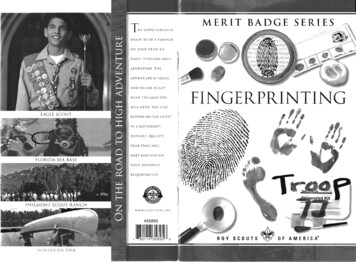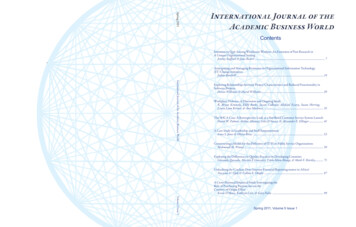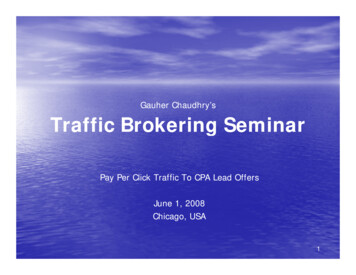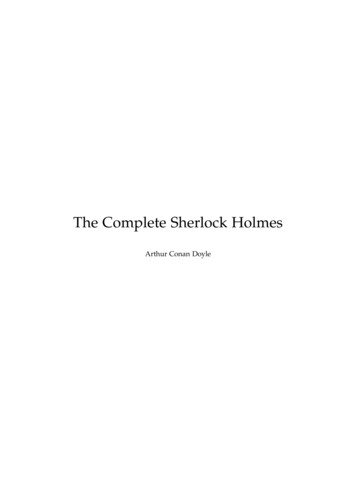
Transcription
IBADGE SERIESl J f S l r f l l \ ! i l r , , L 'r1 5R I : A D Y ' I O] J [ A I A R I N I Ro N Y O U R I R A T rr ( )IE A ( li F J H R ( ) L l ( ; t I H t ( i 1 lffiA D V I ] N T UI \ I ] . T I J I ADVLNTUREI S Y O U1 1 5 .ANI)WI ARLIILAI)YWllFl IHF(itARY()tlW I I - L N i . I ] D .Y O U C A NE A GL E S C O U TD I P E ND O N'IIIEFING ERPRINTINGtLAI'E5'ItN I l(;H I \'!l t(iHlD U R ABt ! . q r A r . l YC E AR T I I A T W I L J MILl'AND SURIASSF L O R I D AS E A B A S EY O U RT o L J G HI S IRT(LUIRIMINTS, tNlft:rI,rr,fffi,ffi-'.NiNyor,It'*i:i{!tiTl@I ' I I I LM O N T S C O U T R A N C HBOY SCOUTSOF AMERtcA'Ilrttr
HOW TO USE THIS PAMPHLET'llrc sccfclto sllcccssiullyearninga meritbaclgeis for you to useboththc pJnlphlct.1nclthe suggestionsof yoru counselor.Youf couDselofc.rnbe as inportantto you as a coachis to an athlete.your counselorcanmakeavailableto you.Usc.rlloi the resources'l'hisInaybe the bestchanceyou will haveto learnaboutthis pa icularsubject.Makeit count.If you or your counselorfeelsthat any inlormationin this pamphletisinconect,pleaselet us know. Pleasestateyour sourceof informatjon.,rry77U i . ) Y5 ( l ( ) l . J T sl ) l A M i :l l l C AM t l r . t Ti l A [ ) c i E5 [ P . l l ]FINGERPRINTINGMerit badgepamphletsare reprintedannuallyaDdrequiremeltsfor iInpfovementarewelcome.updatedregularly-Your suggestionsSendcommentsalongwith a brief stateorentaboutyourselfto BoyScoutDivision. Boy Scoutsof America. 1325Westwalnut Hill Lane.P . O .B o x 1 5 2 0 7 9 . l r v i n gT, X 7 5 0 1 5 - 2 0 7 5 .W H O P A Y SF O R T H I S P A M P H L E T ?This Ineritbadgepamphletis one in a seriesof morethan 100coveringall kjndsoI hobbyand careersubjects.it is madeavail.rblefor youto buy as a serviceol the nationaland localcouncils,Boy ScoutsofArnerica.The costsof the development,writing,and editingof thenerit badSepampirletsare paid for by the BoyScoutsof Americainprice.orderto bring you the bestbook at a reasonablesc0uTs-r4\ qWEOT AMEBICA.
It IIRequirements,\-Iell1 . Cive a short history of fingerprinting.thd differencebetween civil and criminal identification.I!Explaio the difference between the automated fingerprintidentification systems (AFIS) now used by some lawenforcement agenciesand the biometdc fingerpfntsystemsused to contol accessto places like buildings,airports, and computer rooms.3 . Do the following:a. Name the surfacesof the body where friction orpapillary ridges are found.b. Name the two basic principles supporting thescienceof fingerprints and give a b ef explanationof each principle.c. Explain what it takes to positively identify a person,,cindfindamrinrcTake a clear set of pdnts using ONE of thefollowing methods.a. Make both rolled and plain impressions.Make tlese onar 8-by-8-inch fingerpint identification cad, availableftom your local police department or your counselorb. Using clear adhesivetape, a pencil, ajd plain paper,record you.I owtr fingerpints or those of another person.5, Show your merit badge counseloryou can identify the threebasic t,?es of fingerpint pattems and their subcategories.Using your owr hand, identify the trues of pattems you see.358S5lsSN978"0- 95-3287-3@003 BoyScoutsof America2008Prinllng
\\1,',t l\,.Fir.oe \;:IItiWhat Is a Fingerprint?lmaSine tryiDUto pick up an ice cold glass01 w.iter using lhc inside oi your arnt .1ttheeiborv.The sDooth skin oD tllc inside ofyour arln is not designcclto gtip or crcatefriction llle way the ridged sl iuon yourl r t g ,r r ; r . d p . r lr r - u l d r i , ' u c i r E t , r eiDsideoI your elbow, you are nlorc.lil(ely todrop thL'glassthan jl )'orLuse the ffictionskltl" olt ]rour fingeis and palmS.Thc'frictionskin on your toes and thc solesof yoLlf leet servesthe satreprilpose in giviDg you traction on sllppery surfaces.WhcD you tfanslef dift, oil, ink, or othcf substancesfronlthe fliction ridgcs of yoltr fingefsto .i smooth suffacc,vou makefiugerprjlrts.Just like an ink stalnp, the ridges nt.ike contactpalterns on the suri.iceyou iouch. Thc.sh.rpesanil paths of thetops of the iriction fidges appt.u.rs lines in a filtgerpfint.I{IItII i 1 i ; L r . t , L \t t. ji r ' p i s , r o s r l , r r c p dh ' L w e n l o . e r r i e r r t.,rgenciesiD ilvestigatjng crjmes, but tingerprirrtshavc.ot]reruses, too. Law enforcementofficersuse fingerplints,alongwith other lraterials like nlatching deotal recordsand DNAsampling, to help ideDtify a1n[esiavictims, missing persons,abducted children, and others.l g r l . ef j t r g p . p l i n r i t r rge r i tL , , d g er .o r r u i ll e . . t tnbe leafniDs nbout and using an iDportant lechiique i la\,v enforceneDt.T h e f r i c t i o ns k i n c o v e r i n gt h e u n d e r s i d e so f y o u rf i n g e r s ,p a l m s .s o l e s ,a n d t o e s r e s e m b l e st h eridges of corrugatedcardboard.Peelaway thepaper coveringfrom a piece of corrugatedcardboard to see the alternatingridges and grooves.TWoBasicPrinciplesof Fingerprintingln fingerprintingscience,the two basicprinciplesare permanenceand individuality.Permanence.Fingerprintsnever change.lf you draw a face on anuninflatedballoon,then fill the balloonwith air,the featuresof the facew i l l g r o w w i t h t h e b a l l o o na s y o u b l o w i t u p . F i n g e r p r i n tas r e s i m i l a r i nt h a t t h e y r e m a i np e r m a n e n t o, n l y g r o w i n g l a r g e ra s a b a b y g r o w si n t o a n a d u l t . T h es m a l l r i d g e st h a t f o r m o n a p e r s o n ' sh a n d sa n dfeet before birth do not change shape as long as thatp e r s o nl r v e s .lndividuafity. No two fingerprints are alike.The ridgeson a person'shands and feet have distinctive,individualdetailsthat are never repeatedon the handsor feeto f a n y o t h e r p e r s o n .I n m o r e t h a n 1 0 0y e a r so fc o m p a r i s o n so f b i l l i o n so f f i n g e r p r i n t sw o r l d w i d e .n otwo fingerprints have been found to have the samefeatures.Even identicaltwins have differentfinqerDrints.
H l5 t()RY()l f Fingerprinting1J{IEgWEATOLAN'Structule ol friction skinPeoplehavelongbeenaw.rc'of the fidSepatternson theirfingersand palms.On a clifi facein NovaScotia,ptehistot'ic"picturewriting" shows.rh.ucl wilh ridgepatterns.In ancientwereLrsedon cl.ryt.rblelsto conturicsthe Cltinesenesstransactions.to sealdocunenls.p.lperswereIn l4th ssedwitl] fingefprints.one governrnentphysician,observedthat no two essF-ttltlhdr ringerpfl s were irrdiridual1lIThe skin has three layers:epidermis,dermis, and {not shown in thisillustration)subcutaneoustissue.fhe epidermis,the outermost lavel,is about as thick as a sheet of paper over most of the body.The dermis,the middle layer,is between 15 and 40 times as thick as the epidermis.The surfaceof the dermis has many tiny "pegsl' the papillae,that fi1 inlopits on the undersideof the epidermis.Thepapfl/aehelp fasten thedermis to the eDidermis.Friction ridges are technically known as papillary ridges. Scrapes.cuts, and other minor injuries do not changethe ridge structureor thepapillae;the original ridge patternreappearsin any new skin that grows.and distiDct,the scientificapproachto fingerprintinBdid not begin forHereis [l** ;}fM a r c effo M a l p i g h i - 1 6 8 6qkin.D u r , nlgt i ss t u d i eosi h u m d nItaliananatomistandphysician r}ti-rL.'af'.?itfr.0,:ii[:T'*,*': .txl,:"j';Ii'::-ll,i:"fl"spirals,and loopsin fingerp nts.\', ,.-t !H l;"J:',Jt:il:ii::j;:"ot tlreM a l p i g l rmi a d en o m e n t i o noorror;*iilff';;il'::asaiil.rprc(l lrlinr lrrprTontr.orrl/i\.1{Attlrf ilr"
H I s I o R Y O F F I N c I E R fR I N I I N CJohannes Evangelista Purkinle- 1823lolr.rIlresPurl(inje,a Czechphysiologist,createda classificationsvsl('Irlbr the varietyof frictionridgepattems,but his systeml.ulL'(lto generatemuch interestin the value of using fingerprintslof pcrsonalidentification.(:ItlIlIWilliam Herschel- 1858The Englishbeganusing fingerprintsin 1858wher Sir WilliamHerschel,a British official in India, had a local businessmanpresslr ltl{10,Hertryhis handprint on the back of a contractto discouragethe nanl i r ( ( l ss e n tfrom not honodng the agreement.The localsbelievedthat thispersonalcontactwith the documentmadethe contractmore bind0harlesDarwinan cxpranalton ing than if they had simply signedit. Herschelbeganrequiringpalm pdnts-and later,simply the p nts of the right index ando f h i sc l a s s i f i c a - niddle fingers-on every cofltractmadewith loca] businessmen.Herschel'sexperiencein India suggeststhat the first widetror'tsystemandscale,moderfl-dayuse of fingerprintswas basedon superstition,a sampleofthenot science.Howevet as Herschel'sfingerprintcollectiongrew,hetormshe designed beganto seethat the inked impressionscould, in fact, proveor'disproveidentity.He widenedhis use of fingerprints,convincedtor recordingthat the prints were unique to the individual and permanentinkedimpressions.throughoutthat individual'slife.Darwinlatermalerlalsonto hiscousin,FrancisGalton.Henry Faulds- 1880During the 1870sDr. Henry Faulds,a Scottishphysicianworkingin Japan,not only recognizedthe importanceof fingerprintsforidentificatior),but also createda method of classifyingprints. In1880,the scientificjournal NaturepublishedFaulds'articleaboutusing fingerprintsfor personalidentificationand using printer'siDk for taking prints. Dr. Fauldsis creditedwith the first fingerpint identification,of a greasyprint left on an alcoholbottle.GilbertThompson - 1882In 1B82,geologistCilbert Thompsonbecamethe firct Americanto use fingerprintsfor identification.He p nted his own fingerp nts on documentsto preventother people from forginghis work.MarkTwain- 1883Author Mark Twain,whosereal namewas SamuelL. Clemens,broughtfingeryrintinginto the literaryworld with his 1BB3bookLife ot tlle Mississiryr,iD wltich a murdereris identifiedby on,desc besadranatic fingerp nt identificationduring a court trial.Francis Galton - 1892In the 1880sSir FrancisGalton,a British aflthropologistardcousinof CharlesDarwin, begaDhis studiesof fingerprintsasa meansof identification.ID 1892Galtonpublisiredhis book,Fir.gerPrints,describingthe individuality and permanenceof fingerp nts. Galtonwas able to scientificallyprovewhatHerscheland FauldsalrLrdy suspected:that fingerprintsarepermanentand uDiqLre.Accordingto Calton'scalculations,beingthe samewerethe oddsof two individunlfingerpdnts1 in 64 billion.Juan Vucetich - 1892policeofficial,begantheIn 1891JuanVucetich,nn nr8L'rltinefirst fingerprint files brst'rj on Cnllon palterntypes.In 1892,HeVucetichmadethe firsl cfinrin.rlfingerprintidentification.was ableto idertiiy.r 1lrf(l('fsuspectfrom bloodyfingerprintsat a crime scene.Henry System - 1901identificatioDt]eg,rnto l)r'usorlh[ crirniDalh 1901fingerpriflts'lhcsystemwas basedrl,rssilic.rliolrin Englandand Wales.tcvist'tlby Sif lilw.lrd ltichardol Galton'sobservatio s,.rssystcnl,wlrichisHenly.This beganihc Ilcrrry(ll,rssili.rtir)r)finll('fIfirlliilcs in linglishstill usedtodayfor ronconrl)lllcli/('(lspeakingcount es.First Uses in the United States- 1902-1903Stateswns intfo(lu(('(li l eganin 1902when the New YorkL-ivilSofvi('ofingerprintingits job applicints.lrr 1903,tlrc N('rvYofkStateprisonsystembecameth('iirsl .rllfncyin lhe LJnilcdSt.ltestoto ingerprint Bureaus- 1904I(nnsJs,.rndthc St. Louisat Leavenwo lh,The penitentiarybufeaLlsil1 ]904.establishc(lfinl.lcq)fi llPoliceDepartmentbureaubecinlc thr'fiNt lo operateoD moreThe Leavenworthto oiler n iree fingerprintthan a local basis.It gradu.rllyL)eg.rnlawserviceamongn Sfowinglist ()l estillin usetoday.Theyareoftento asreferred"Gaiton'sdetails."
( I tit lt \l I ll\(;lll\lr'l(r!.r Il\r,llFirst American Military Use- 1905The U.S.Amry adopteda furgerp nt systemfor its soldiersin1905.Two yearslaterthe U.S.Navy startedusingfirgerprints,followed by the Marite Corysin 1908.,tInternational Exchange- 1932The FBI IdentificationDivision beganto exchangefingerprintirformationwith foreigncountriesin erprintrecords.First PrintTaken From Human Skin-1979hl a 1979Miami,Florida,murdercase,a latentfinvisiblelfingerprintlifted from the victim's hand led to the identificationof the suspect.This was the firstcaseiD which a firgerprintwas taken from htunan skin and successfullyused to identifvand convicta criminal.Integrated Automated Fingerprint ldentificationSystem - 1999lbday, computersperform fast electronicsearchesfor fingerprint matches.In 1999,the FBIimpleDeirtedits 2tst centuryIntegratedAutom.ltedFirgerp nt Ideltification System,whichallows usersto quickly scanevery fingerprintcard in the FBIcriminalfiles.Whereasa singlephysicalsearchthroughfingerprintson papercardscouldtake40 days,the IAFIScan do itiD two hours or less.Tl]e systemalso allowsusersto natingthe needtoexchangepapercards.The AutomatedFingerprintldentificationSystemis the firstphaseof IAFISdevelopneni.When this technoloBywas introducedin 1999,the fingerprintfileswerespljt iuto computerizedcriminallilesand manuallymaintainedcivil files.The filrgerpdntsol peoplewho havebeenchaBedwith seriouscrines arein the criminal files. 40 millioncrirrinalfiles.\',ln 1993theldentificationFBI ldentification Division- 1924In the early yearsof the 20th celltury,more and rnorelawenlorcenreotagenciesbegaIrusing fingerprintsystens.In 1924,Congressestablishedthe IdentificationDivision of the FederalBureauof lDvestigation.More than 810,000fing
Merit badge pamphlets are reprinted annually aDd requiremelts updated regularly- Your suggestions for iInpfovement are welcome. Send comments along with a brief stateorent about yourself to Boy Scout Division . Boy Scouts of America . 1325 West walnut Hill Lane. P.O. Box 152079.lrving, TX 75015-2075. WHO PAYS FOR THIS PAMPHLET?











